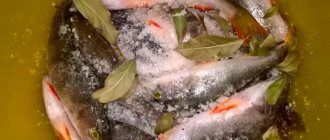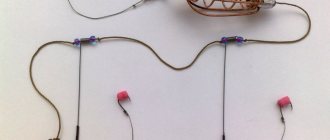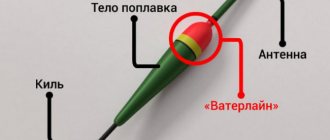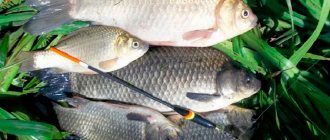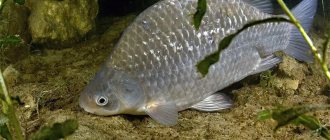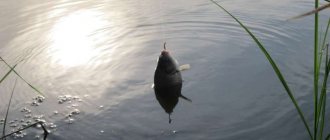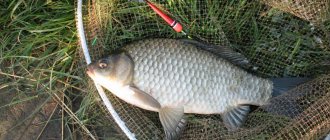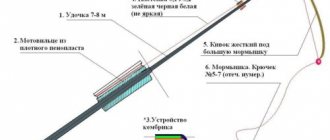The process of catching crucian carp in winter is something unattainable for some anglers, but for others it is commonplace. Winter fishing for this fish requires the manifestation of fishing skills, ingenuity and lack of laziness. A classic of the genre - the bait is not the same, then the crucian carp takes jigs to play today, and tomorrow on a stationary bait. In the southern regions, where crucian carp (hybrid) forms the basis of fishing catches, catching this fish is the main activity of winter fishermen at this time of year. In this article we will look at the features and secrets of catching crucian carp from ice.
How does crucian carp winter?
Crucian carp hibernate in winter only in shallow muddy ponds, swamps and lakes in the northern regions. However, in these places the population is relatively small. After all, the hybrid is a heat-loving fish, demanding on the level of oxygen in the water. The life cycle under ice is directly influenced by biological features and high adaptive ability to adapt.
- This representative of the ichthyofauna is tenacious, easily adapts to difficult conditions, overwinters in silt, in reservoirs that freeze to the bottom, and the latter (except rotan) dies when killed.
- But this does not mean that crucian carp likes low oxygen content in water. The hybrid prefers water saturated with this gas, like roach or perch, but to a lesser extent than grayling or pike perch. In addition, in cold water the metabolism of fish is inhibited, and the silver prefers to hibernate (anabiosis) until better times.
- For this, suitable conditions are needed - the absence of a sufficient layer of water between the ice and the bottom, thick silt , into which the hybrid burrows, becoming covered with protective mucus. In cold water, crucian carp swim for weeks in a barrel, but in a basin with warm water it will not live even three days, it will fall asleep.

Features of behavior under ice
Fishermen constantly argue whether crucian carp sleeps in ponds in winter. Yes, but in shallow water, freezing to the bottom and with a thick layer of silt (0.5 meters or more). If there is nowhere to sleep, the fish feeds slowly and waits out difficulties “on the fly.” It is possible to catch crucian carp in such reservoirs in winter, since the fish require nutrients to maintain their vital functions, although an order of magnitude less than in summer. Therefore, in reservoirs without a thick layer of silt, crucian carp stay awake in winter and feed from time to time .
Hybrid, dushman, buffalo
In the southern regions (Rostov, Volgograd, Astrakhan regions and further south) silver thrives. The usual trophy here, including during winter fishing, is a hybrid of 0.7-1.5 kg. A half-kilogram hybrid is considered small. And in winter in these places the hybrid is a frequent representative in fisherman’s catches, along with roach, ram, and roach. The name “hybrid” comes from these places. In fact, this fish is the common silver crucian carp, which supplanted our native “golden” due to evolutionary advantages:
- Adaptability to external environmental conditions. The hybrid is ubiquitous - rivers, ponds, reservoirs, lakes, shallow waters become permanent habitats. Unlike its golden counterpart, silver crucian carp feels great in rivers with strong currents.
- On the Don, lower Volga, Kuban, in reservoirs and tributaries of these rivers, silver crucian carp thrives, reaching impressive sizes and weights (rarely up to 4 kg, and usually up to 1.5 kg). For reservoirs in the middle zone, a normal specimen is crucian carp 400-700 grams.
- Viral spawning. The eggs of this fish are fertilized by the milk of related cyprinids - gynogenesis (hence the name - hybrid) - golden carp, carp. The places and timing of spawning of these fish coincide. And at the exit from such caviar, silver crucian carp grows. 90% of the population are females.
- By the way, that’s why the name “hybrid” has stuck with crucian carp. Here and there you can find the names “dushman” or “buffalo”. Buffalo is another fish that is not related to the hybrid, even in appearance it is very different from our silver crucian carp.
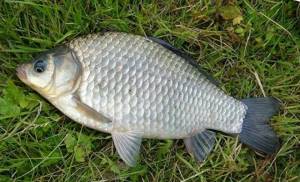
Silver crucian carp (hybrid, dushman, in some regions mistakenly called buffalo)
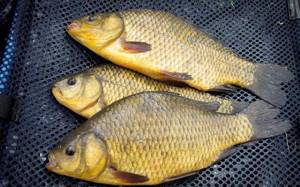
Golden carp
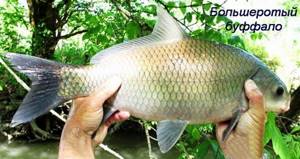
Real North American Largemouth Buffalo
What does crucian carp do in winter?
- In the northern latitudes, where silver and golden crucian carp inhabit numerous ponds and swampy lakes, peat bogs and oxbow lakes, in the harsh winter these heat lovers sleep, buried in the bottom sediments. In the south of the European part, the Urals and Siberia, the hybrid is active in winter in reservoirs where it is impossible to bury itself in the bottom. In harsh winter, the fish are passive, often bite slowly, mulling over the bait for a long time.
- Crucian carp is a benthophage and loves to rummage through bottom sediments in search of organisms living there, bloodworms and other larvae. However, in the warm season, the silver glutton also eats plant foods. In winter, the body's metabolism slows down.
- The fish cannot move actively and eat a lot. Therefore, she tries to spend as little energy as possible searching for food in order to conserve strength. The main baits for ice fishing are high-protein, animal-based, protein-rich .
- Crucian carp are active at the beginning of winter . When there is first ice, there is often a gorging, but not immediately, but after a week, when the hybrid adapts to the new reality. With the onset of deep winter, activity decreases, schools of fish stand at points, sluggishly moving to places with a stable oxygen regime and the availability of food. But even on such days you can catch crucian carp in winter - if you find a parking spot and offer the right bait.
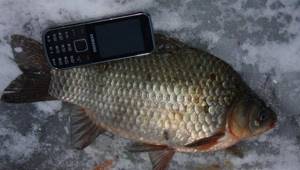
Rivers, ponds, reservoirs - winter behavior in various types of reservoirs
By spring, biting and fishing activity increases again. Although it is still cold, the females develop eggs and require more nutrients. To activate the bite, a slight thaw is enough, when fresh melt water begins to enter the reservoir.
On ponds at this time, silvery gourmets move from deep places to the shore, to the edge of vegetation, where there is more food. And in reservoirs they return from holes and flooded channels to an average depth of up to 5 meters. The flocks become larger and move closer to the mouths of inflowing rivers and to extensive coastal shallow waters.
It is impossible to say in general terms in which part of the reservoir the crucian carp winters - conditions are unique everywhere. But the hybrid does not slide into holes, ten meters deep, like bream. More often, the fish move sluggishly near summer camp sites. In small ponds, during periods of inactivity, fish stand in places with the greatest depth, 3-6 meters , moving during thaws and by spring to shallow waters or coastal edges. Common winter locations for silverfish are quiet pools, snags and bottom depressions at appropriate depths.
On large reservoirs, migrations occur continuously throughout the year. The winter mooring site can be, for example, a bay with a depth of 5-6 meters, and by spring the schools move closer to the mouth, to the shores with thickets of reeds. As the ice melts, the running hybrid rises upstream of tributaries to spawn, tens of kilometers away. Local crucian carp, which do not migrate, enter nearby overgrown bays and backwaters.
Behavior of carp in winter
What time to catch
The time of greatest activity of carp in the pond depends on the period of freeze-up:
- First ice - with little snow cover and an ice shell that has not yet had time to gain much strength, carp actively feeds from early morning until 2-3 o'clock in the afternoon.
- Deaf winter - like most fish, carp are very passive at this time. In the wilderness it feeds for a very short period of time - from 15 to 20-25 minutes. Carp hatches most often occur in the afternoon. The bite improves significantly during cloudy, prolonged thaws with light snow or rain - in such weather, carp can feed for up to several hours. Completely stops feeding in severe frosts, with a sharp drop in atmospheric pressure, on days with strong winds, snowfalls and blizzards.
- Last ice - on the eve of spring, carp activity increases again and on sunny days with mild frost or slightly positive temperatures, carp feed for 4-5 hours a day - from 10-11 am to 2-3 pm.
Where to fish
Carp are caught in ponds in places where they escape the heat in the summer:
- In winter, carp can be found in ponds with depths of up to 3 meters, and in the first ice and not far from the shore,
snags flooded at great depths; - sharp drops into the depths under steep banks;
- lower edges of deep holes;
- whirlpools;
- channel ditches of rivers and streams that formed ponds;
- places where warm treated wastewater flows into the pond;
- channels through which warm waste water is discharged into the pond from the power plant.
- holes and places with great depths and a constant influx of fresh water near the hydraulic seals of pond dams.
In ponds with depths of up to 3 meters, however, on first ice you can find carp not far from the shore.
In large reservoirs with fairly varied bottom topography, carp prefer to stay in areas with depths of at least 4-5 meters all winter.
What and what to catch
Unlike the species familiar to winter anglers - perch, white bream, roach, silver bream - carp offers quite strong resistance when fishing. Therefore, the tackle for catching it must be stronger and coarser than those used for catching other fish.
However, when configuring the tackle, it is important to take into account the size of the fish that can get hooked - the use of thin tackle when fishing on a pond where trophy carp are found is likely to lead to a line break or hook breakage when fishing, while the use of very coarse and A clearly visible rig on a pond with small carp will significantly reduce the number of bites.
fishing line
When fishing for carp in winter, use both monofilament and braided fishing lines:
- When fishing for small and medium-sized carp, monofilament is used with a cross-section from 0.12 to 0.16 mm, for medium-sized carp - 0.18-0.2 mm; large – from 0.2-0.22 to 0.3 mm;
- braided fishing line uses a cross-section from 0.06-0.08 to 0.12 mm.
When using thin monofilament lines, their color has little effect on the catchability of the tackle, but if they use monofilament with a cross-section of 0.2 mm or more, then they try to choose its color so that it is as invisible as possible in the water - dark-colored fishing lines are best suited for this.
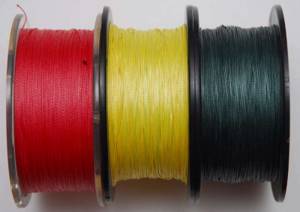
Monofilament line
Float
When using a winter float as a signaling device, this element of gear is placed larger and more clearly visible than when fishing for roach and bream. So, at slightly sub-zero temperatures, small “wagglers” or two-piece winter floats are used.
At lower temperatures, floats with a flat body of the “tablet” type are used. During the thaw, preference is given to large sliding floats up to 45-50 mm long.
Since carp are caught at great depths, the color of its body can be of any color - in muddy water the fish is unlikely to notice a float located 4-5 meters above it.
The top of the alarm, painted in bright red or poisonous green, is submerged relative to the water level in the hole by 1-2 cm - this allows you to most clearly see the bite and prevents the float from freezing into the ice that forms on the surface of the water.

Wagler
Nod
Since carp are caught using jig tackle using a less active game than for perch, the nod should serve more as a signaling device than as a catalyst for oscillations of the bait.
Therefore, gear for winter carp fishing is selected with the following characteristics:
- Length 15-20 cm.
- The material of manufacture is lavsan or a metal flat spring.
- The color of the nod should be bright, allowing you to see the bite from a short distance.
- The nod must be secured in a rubber holder, with which it is attached to the rod of the fishing rod. The holder also allows you to change the length of the guard, thereby ensuring adjustment of its sensitivity for fishing with baits of different weights.
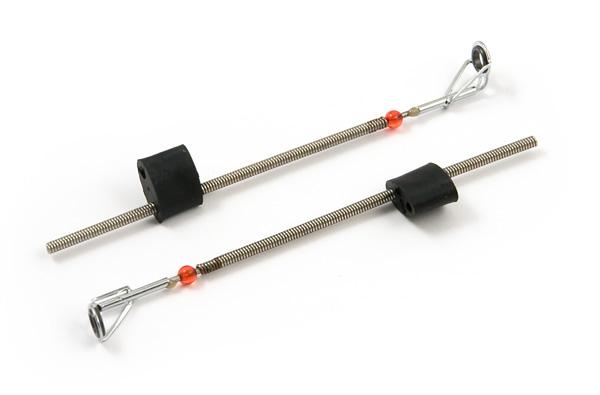
Nod
Jig or hook
When fishing for pond carp in winter, jigs are most often used.
Of the variety of these baits, fish prefers in winter the following types:
- "Pellet";
- "Uralka";
- "Ovsinka";
- "Crystal."

Pellet
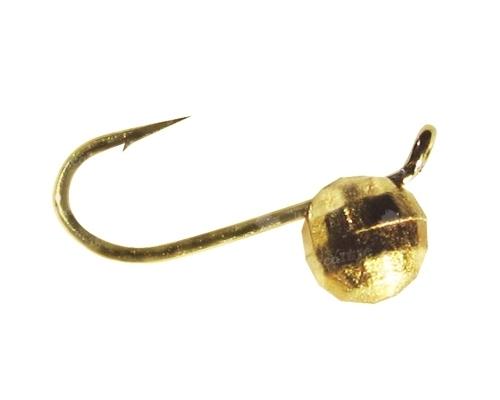
Kristalik

Ovsinka
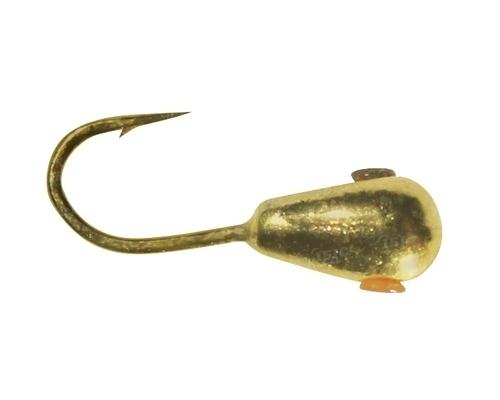
The size of the jigs used should be at least 4-5 mm. in length.
Carp respond best in winter to baits of the following colors:
- golden;
- silver;
- yellow;
- white;
- green and dark green.
When fishing for carp, many fishermen make jigs specifically for such fishing, using durable, high-quality and sharp hooks.
Fishing rods
There are two types of fishing rods:
- “Balalaikas” are fishing rods in which the reel acts as a handle. Used when catching small and medium-sized carp with a jig in small ponds. This type of tackle makes it easier to play; the risk that they will be pulled under the ice by a small carp is very small.
- Classic fishing rods with a handle - such fishing rods are used when catching large carp with a jig and float tackle in medium and large ponds. Fishing rods of this type are more stable on ice; even large carp find it difficult to pull them into the hole; Compared to balalaikas, they have a reel capable of holding the required volume of fairly thick fishing line.

Fishing rod Balalaika

Fishing rod with handle
Nozzles
In winter, carp prefer baits such as:
- bloodworm;
- maggot;
- burdock.
Less effective, but still from time to time, carp like the following baits of plant origin:
- canned corn;
- peas;
- pearl barley;
- sinking boilies of small diameters (10-12 mm) with bloodworm and squid flavors.
Bloodworms and maggots are baited with 5-6 larvae per hook, burdock is used in combination with bloodworms or maggots. Plant baits are used in sandwiches with bloodworms and maggots.

Bait for carp fishing
Lure
Just like in summer, in winter bait plays a huge role when fishing for carp: it must attract and keep fish near the jig or hook with a nozzle.
However, in cold water, carp feed less actively and in order to get enough food they need significantly less food than in summer - this suggests the first rule of winter feeding, which states that excessive feeding will lead to oversaturation of fish and complete lack of bite.
Store-bought and homemade baits are used:
Of the purchased ones, universal mixtures are used for catching carp or crucian carp.
Homemade ones include the following components:
- breadcrumbs - the basis of bait;
- undercooked millet – makes the bait heavier and gives it an attractive appearance for fish;
- powdered milk or crushed roasted peanuts - additives that add flavor to the mixture;
- Rye bran is a filler that gives volume to the bait.
Flavorings are not used in such bait - odors spread very poorly in cold water, causing an increase in the concentration of flavoring in a small volume of water in the bait poured onto the bottom, which scares off carp, which has a keen sense of smell.
The bait is mixed directly on the spot, diluted with water from the hole. The amount of mixture prepared should be small, sufficient to feed several drilled holes.
It is not recommended to leave the mixed bait for a long time in winter - the water in it freezes and when using such a mixture, due to ice particles, it becomes excessively buoyant, rising high above the bottom and attracting small fish.
They feed at a depth of up to 3 meters, rolling small balls from the infused bait and throwing them into the hole by hand; In deeper areas, winter feeders and dump trucks are used.
After the bait has been thrown into the hole, a small pinch of food bloodworms is added there.

Bait for carp
Is crucian carp caught in winter?
A frequent question among fishermen from the middle zone is whether it is possible to catch crucian carp in winter. In some reservoirs in the south, the hybrid is the main object of winter fishing and catching. Winter crucian carp is capricious, but can be caught consistently without problems, especially towards the end of winter. It depends on the specifics of the place - weather, region, conditions of the reservoir. Sometimes the silverfish refuses to feed, but the very next day, with a change in the weather, you can catch a lot. Fishing for crucian carp in winter on a new reservoir is a lottery.
However, if an angler can constantly and often visit a pond in winter, then over time the subtleties and nuances of biting in this particular place become clear. Where to fish in winter, with what, in what weather, in a hole or near the shore, on a riser or a game - these points are specific to each individual pond, river or reservoir. Winter crucian carp requires attention to a greater extent than summer crucian carp.
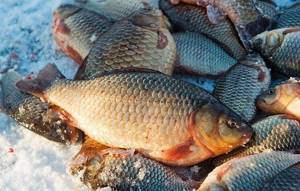
The influence of weather on fishing
One of the important factors in winter crucian fishing is the weather. More precisely, the change in the level of oxygen in water depending on atmospheric pressure and the temperature in winter under the ice. The bite of crucian carp in winter is unstable, one of the reasons for this is the weather. There is a lot of conflicting information on the Internet and literature.
Silver loves thaws and stable weather, without sudden changes or jumps. However, it is often possible to catch good fish for this fish in completely different manifestations of the atmosphere: during a drop in pressure, during a sharp increase, on sunny frosty days, in windy blizzards at night, snowfalls and ice flakes.
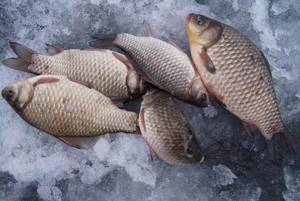
Without a doubt, the weather affects the winter bite of crucian carp, but the specifics of this influence are tied only to a specific body of water, based on personal observations. It is impossible to say globally in what weather the bite is better. The only accurate remark is that during the thaw, silver becomes more active. We do not consider the weather as a factor in going or not going to a body of water.
Depending on atmospheric conditions, various baits, baits and fishing methods work better or worse. And these moments need to be noticed and taken advantage of. When there is a north wind in the cold, the crucian carp usually stands in the hole and takes one bloodworm from the bottom to stand, and in the thaw it comes closer to the bushes and reacts to the sluggish play of the black jig at the bottom. Naturally, such observations are tied only to one, specific fishing location.
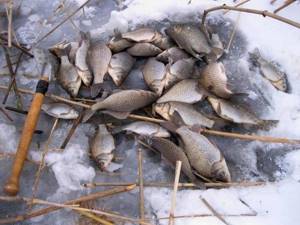
Fishing with a winter float

Two types of gear are used for winter fishing for crucian carp: a jig and a float rod. Crucian carp almost always take food sluggishly and lightly savor it on their lips before swallowing. Moreover, while savoring the bait, the fish often gets pricked, and it is almost impossible to catch it without timely and accurate hooking. The float is capable of showing even the lightest and most careful bite. Therefore, a float rod is used in cases where crucian carp is shy and does not take bait from a hook with a soldered sinker.
However, for winter fishing with a float it is necessary to take into account some nuances, namely:
- on the surface of the water during winter fishing, the self-hooking float quickly becomes icy and becomes insensitive to careful bites;
- It is recommended to bury the float in the water no more than 3 cm from the surface, otherwise it will be inconvenient to observe it in the hole;
- for winter fishing you need to use cork or foam floats of cylindrical and cone shape;
- for better visibility, the float should be brightly colored;
- the dimensions of the float should not exceed 30-35 mm in height and 4-6 mm in diameter;
- in a vertical position in the water, the float is held with the help of a sinker - an olive-shaped lead pellet;
- the weight of the sinker must be calculated so that the float is immersed in the water with little effort, the nozzle must be held at the bottom of the reservoir;
- the hook on the float rod should not exceed 2.5 - 3.5 mm.
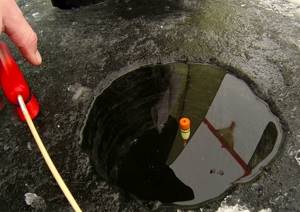
Since the crucian carp takes the bait very carefully and moves it slightly to the side, the float first moves in this direction and then seems to freeze. It is this moment that should not be missed for hooking. Less often, the float seems to bounce in the water before moving to the side.
For winter fishing with a float, there are two types of fishing rod equipment - for fishing in the water column and for fishing from the bottom.
Plumb fishing is used in stagnant bodies of water and makes it possible, by moving the float up or down along the line, to move the bait in different layers of water. For such fishing, one or more pellets are attached to the fishing line at a distance of about 20 cm above the hook. Moreover, the top pellet should be the heaviest, and the one closer to the hook should be the lightest. The distance between pellets also increases from lightest to heaviest. The float in this case should have a high pointed top or a rod that protrudes 2-3 mm from the water.
Fishing from the bottom is used when there is a current. In this case, the sinker should be selected depending on the strength of the current, and a sliding olive should be placed 30-50 cm from the hook.
The following video shows in detail how to lower a float for catching crucian carp in a pond in winter.
Finding a fishing spot
The next question is how and where to catch crucian carp in winter. Every new body of water is an open book. Theoretically, predicting where the fish are standing is difficult. It’s easier to look for crucian carp in a pond in winter - there are fewer options. The flock either stands in a hole, or at the coastal edge, or in shallow waters in the bushes. In such places we rely on other fishermen.
On frequently visited ponds, fishing spots are constant due to the developed unconditional reflex to the noise of ice drills, fishermen on ice and bait. Where there is a buzz, there is a bite. In other places, on the contrary, the hybrid is shy in winter and avoids crowds of fishermen. The bite in such places is unpredictable - it can either start abruptly or stop just as quickly.
Possible points to check
Ice fishing for crucian carp in winter on reservoirs is of a different nature. Here the fish are much more active, biting even in the harsh winter. But it is difficult to find it in large water areas in winter. Places to search and catch:
- Bays, coastal tables, areas with an average depth of 3-6 meters with algae and irregularities on the bottom.
- Silted, shallow areas.
- Thickets of reeds and reeds in the water.
- In the wilderness there are open, fairly deep-water places, edges, underwater irregularities (no more than 10 meters).
- During the first ice and closer to spring, crucian carp fishing is successful near the shore, in bushes and reeds, in thickets or next to them in open water, closer to river mouths.
- By spring, schools of sea crucian carp approach the mouths of tributaries of reservoirs, preparing to enter the spawning grounds.
- You can find and catch crucian carp from the ice in a large pond on holes, snags, unevenness on the bottom, under coastal dumps.
These are just general trends in winter silver fishing. In practice, it often bites in non-obvious places. The main thing in this matter is constant experimentation with finding a fishing spot, supplying bait, and playing with a jig. One good thing is that silver’s favorite places rarely change.
In small bodies of water, you need to fish in winter approximately in the area where the bite was observed in summer, perhaps a little deeper, somewhere nearby. On large reservoirs, winter crucian carp can be found anywhere, but more often in areas where roach, small and medium-sized bream are concentrated. Here you need to know the general trends in the migration of the main fish stock and the peculiarities of biting. Somewhere in the general mass there is also crucian carp grazing.
Do you need bait, and how to improve the bite?
For winter fishing to be successful, you cannot do without feeding. Perch, bleak, and bream immediately react to the appearance of food, and after a while predators flock to them as bait: pike, pike perch. But it is also possible to carry out targeted feeding of predatory fish using chopped worms or bloodworms.
Organizing complementary feeding of fish in winter is quite complicated, as it requires taking into account many factors:
- feed viscosity, which depends on the depth of complementary foods and the presence of current;
- colors (it must match the color of the bottom);
- method of delivery to the water (without additional devices, using a feeder-dump truck or a stationary feeder).
The component composition of the feed mixture depends on the type of fish and reservoir:
- in stagnant waters, the main ingredient of the bait should be bloodworms;
- On the river and on the reservoir near the shore, bloodworms work well, and at depth - jigs;
- on old river beds, chopped worms should be added to the bait mixture.
However, bait tactics are always approximately the same:
- For complementary feeding, several holes are prepared and the feed mixture is poured into each.
- You should fish each hole one by one to find out where the fish have gathered.
- Feed should be periodically added to the holes in which a bite is detected.
How to catch crucian carp in winter
The process of fishing for crucian carp in winter from ice depends on the conditions of the reservoir, the fishing gear chosen by the fisherman and tactics, active or passive. In winter, it is not the fisherman who dictates the fishing conditions, but the body of water. The bite during fishing can be sluggish; it needs to be activated by offering the silvery a tasty bait. In one place in winter, feeding at a point works better, in another - constant searching and running around. Both winter fishing for crucian carp in a tent with bait and fishing with active search in a reservoir can be successful.
Gear selection
The following gear is most often used to catch crucian carp in winter:
- Winter float fishing rod, with jig or hooks. A fishing rod for crucian carp in winter is usually equipped with one small, inconspicuous jig, precisely adjusted to the float. During periods of activity, crucian carp in winter can take large jigs and thick fishing line. However, the majority of the time, silver is still passive, it is better to use delicate equipment - no more than 0.14-0.12 mm, as well as small jigs of 0.3-0.5 grams (if the current allows).
- A nod fishing rod is a similar tackle, but instead of a float, a nod is used to signal a bite. A properly tuned nod is even more sensitive than a float. The guard works great when biting on the rise. The advantage of this gear is the ability to combine passive fishing with a riser and active play with a jig. Sometimes the crucian carp is affected by simply moving the bait, or slowly lowering it to the bottom. During periods of active biting, he takes a silver one with a regular active jig.
- A winter fishing rod equipped with a rocker arm is quite heavy and rough. An effective tackle in reservoirs where there are a lot of crucian carp, and they are not particularly shy.
- The reelless reel works best on roach or perch. It’s better to use natural baits in winter. However, in some reservoirs, due to active biting, silverfish take in winter even on bare active bait without bait.
- Winter donks, for example, winter fishing with a “crucian carp killer” or a mini-feeder in the ice version. It is advisable to use donks on rivers with a current, where the use of light nodding or float rigs is impossible. In large rivers on the current for crucian carp in winter I also work with bream under-ice bottoms - descents, helicopters, banks.
In winter, crucian carp resists sluggishly; it is better to use thin fishing lines, 0.1-0.14 mm, when rigging fishing rods. Only for the largest hybrid, when biting on the last ice, it makes sense to put a thicker fishing line - 0.14-0.16 mm. Jigs and hooks are small. Accordingly, the nods and floats are adjusted to the load according to the principle of weight compensation. More information about setting up winter fishing rods:
https://podlednik.ru/snasti/podlednye/osnastka-zimnej-poplavochnoj-udochki
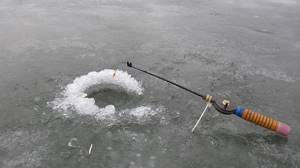
- If you are going to be fishing in an unfamiliar place, it is easier to start fishing with a thin winter fishing rod and a small jig of black or dark green color, with bloodworms attached.
- Jigs are widely used both for stationary fishing on a riser with nodding and float rods (as a lower bait), and for game fishing. These are ordinary uralkas, boats, droplets, pellets, carnations.
- Some fishermen deliberately practice reelless fishing to catch crucian carp in winter. Read more about winter jigs for crucian carp.
Some nuances
Setting up winter gear for silver requires a special approach - there are no small details here. An additional leash 5 centimeters from the bottom can make fishing possible, but 10 cm will not bring a single bite. Today it will take you at the bottom, and tomorrow it will be a sluggish twitching and slow rise. In winter, a fisherman needs to initially tune in to experiments in the process of catching crucian carp.
If it doesn’t take it from the bottom with a large white jig, we put a black one. It doesn’t bite on one bloodworm – we hang up a bunch. For a long time there are no bites at all - we take the fishing rod in our hand and tap it on the bottom, move it, and slowly lift it up. And so on always until a working version of fishing tactics and equipment is found.
Add to this the possibility that there is simply no hybrid under the hole, and you need to change the place - fishing turns into a lottery. The most persistent experimenter will get a decent result in winter. Of course, there are days when you find a cool place and the crucian carp starts to be caught right away - but again, this is not an accident. The fisherman probably came to the place knowingly, with the right bait, equipment and bait.
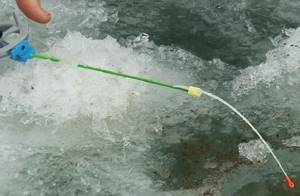
Lures: what to fish with in winter
Lures for fishing in winter are divided into natural and artificial.
Natural
Natural varieties of bait include:
- Bloodworm is a mosquito larva that is good for catching most types of fish. Bait does not last long.
- Maggot is a fly larva with a longer shelf life. It is good for catching crucian carp, perch, and roach.
- Codling moth larvae that live in apples and have a pleasant smell. White fish bite on them.
- Bark beetle larvae, which are also eaten by white fish.
- Worms. They are effective for catching predators in winter, such as perch and pike perch.
- Mormysha is an amphipod crustacean, which is a rare but effective bait for catching both peaceful fish and predators.
Artificial
According to fishermen, when fishing with jigs, winter fishing brings the most catch. However, there are other equally effective methods of winter fishing, for example, with a balance beam, with a “devil”, or with “eggs”. It bites well on a spinner in winter.
All these baits have many varieties, differing in appearance, shape, size, color, weight and method of fishing with them. The choice of bait depends on the preferences and experience of the fisherman.
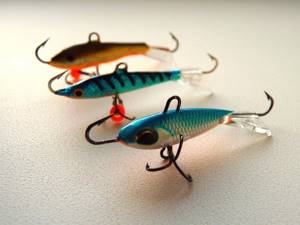
Fishing tactics
Ice fishing for crucian carp can be active or passive. Search fishing is rarely used in winter, usually during thaws or on the last ice, when crucian carp are actively moving. The best option is something in between. Feed holes in several places and fish in order to find feeding fish.
In large water areas, the distances between such points reach several hundred meters. You need to determine where the bite is - in the bushes, at depth, on a dump or somewhere between the drops. In places where there are repeated fishing trips, on small rivers and ponds, in this regard, winter is easier - usually fishermen feed and wait for the school to approach, since it is known that crucian carp spend the winter here.
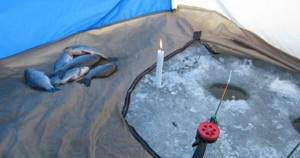
Night fishing
On some reservoirs in winter, catching crucian carp at night will be more successful. I encountered this, for example, at the Tsimlyansk Reservoir in February - the areas are large, the water area with crucian carp is hectares of ice surface. Fishing tactics: feeding and waiting. I fed in the evening and set up a tent. The best bite was observed in the evening and before midnight, then after a pause - in the morning. And in the light there is silence. In such conditions, it is important to strategically choose the right place and know that the silverback is wandering nearby somewhere. In bad weather, you can feed and sit in a tent, and in good weather, you can walk around and look.
The hybrid has an ultra-fine sense of smell, so it can feed in complete darkness, guided by smells and tastes. The taste buds of this underwater gourmet recognize several milligrams of sugar dissolved in a cubic meter of water. Often it is in the dark in winter that it is possible to catch the largest specimens, which become less cautious at night. Fishing for crucian carp from ice late in the evening and at night in some reservoirs is a promising activity.
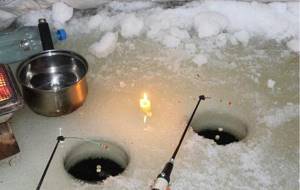
Baits
What is the best way to bite crucian carp in winter? Of course, for bloodworms - this is its natural food. This bait is easy to get, and in general, it’s better to invent something with equipment, finding a place and bait. And live bloodworms almost always work in winter. When a hybrid is capricious, you can also offer him:
- Maggot;
- Chernobyl larva (burdock moth);
- Worm;
- Dog or cat food from bags (soft);
- Sometimes he even takes semolina or pea mash from a syringe, dough with honey on egg yolk, or rolls of bread.
- Steamed peas, pearl barley, rolled oats flakes.
All this is studied in each reservoir separately - the tastes of fish differ. And in some places they are very specific. Sometimes, even in winter, adding some kind of very unobvious smell - kerosene, garlic, Vedashka (WD-40), mosquito repellent, asterisk or Corvalol works, just like in the summer.
If it doesn’t bite, then it’s better to catch crucian carp in winter simply with bloodworms, experimenting with baits, fishing spots, jigs and the method of presenting the bait. The main thing is to keep in mind the tendency of winter fish to become apathetic; if the bite is bad, everything needs to be reduced and thinned - the diameter of the fishing line, the size of the jig, the number of bloodworms on the hook.
The first and most effective method of activating the bite in winter is to try fishing with a game, sluggish movement or rises. Active fish, on the contrary, can be provoked by fairly dynamic wiring. The entire range of summer plant baits for crucian carp usually does not work in winter, but it is worth having a syringe with semolina in stock.
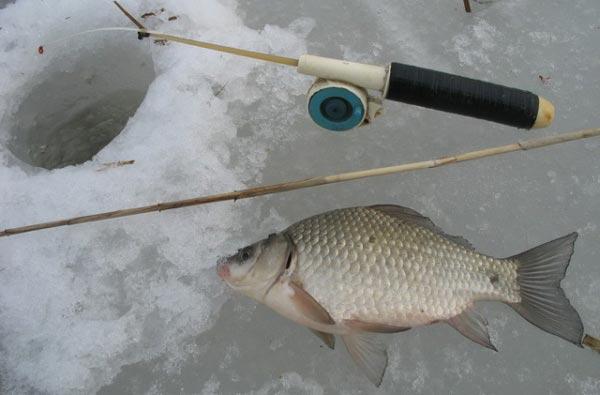
Lure
In winter, the best bait for crucian carp is bloodworms, at least a pinch in each hole. But if you don’t have it, you can use plant mixtures with the addition of live bloodworms. Both store-bought and homemade mixtures are suitable for fishing - based on millet, corn grits, semolina, and breadcrumbs. With the choice of bait, everything is the same - in different bodies of water, crucian carp react differently in winter. I have been in situations, especially on ponds, when a plant mixture in the winter completely discouraged the bite, and the fish were caught only in holes without feeding at all or with bloodworms.
- It is extremely important to know the preferences of silverfish on a particular body of water. In some cases, in winter, adding dry semolina, breadcrumbs or raw millet to the hole works well. In others - only animal components, or some specific aromatics. in some reservoirs, the crucian carp generally leaves from under the hole if you throw anything there other than a hook with bait.
- In any case, winter bait should be sprinkled in small portions so as not to saturate the flock, but only to attract it. In winter, she doesn't need a lot of nutrients to get enough food. In addition, you need food that is easily digestible and contains protein. The same fertilizers are used when fishing in open water in early spring and late autumn - natural, finely dispersed and inert.
- The only exceptions are cases of early and long-term feeding on specially created feeding tables for fishing. In the standard case, complementary feeding in winter should be done regularly and in small doses.
Article about winter bait for crucian carp:
https://podlednik.ru/nazhivki-i-podkormki/prikormka-na-karasya-zimoj-svoimi-rukami-v-domashnih-usloviyah
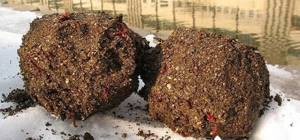
Lifehacks
Fishing requires ingenuity and ingenuity from the fisherman, especially if fishing occurs in winter, which has the most difficult conditions.
How to prevent the hole from freezing?
Setting up a tent or snow wall can help keep the hole from freezing. However, if there are several holes, then you cannot put a tent on each one.
To prevent the holes from freezing, you can do the following:
- drop 1-2 drops of vegetable oil into each of them;
- prepare circles from linoleum or dense polyethylene and cover the holes with them, and punch a hole in the center of each for the fishing line;
- Take old buckets from home without a bottom and place them in the hole.
Illumination of holes for winter fishing
When fishing in January, when daylight hours are as short as possible, you can use backlighting to lure fish to the hole. It is easy to make with your own hands using available materials.
You need to take a simple battery-powered flashlight and wrap it in several layers of cling film (it does not allow water to pass through), then treat the unscrewing parts with silicone, attach a fishing line, and the light is ready.
If necessary, it can be made heavier. You should not place both a flashlight and a fishing rod in the same hole, as the fishing lines can get tangled. A separate hole should be drilled for the lantern.
How to darken a hole during winter fishing?
Darkening the hole is an important condition for productive fishing. From below, the fish sees the hole as a bright spot, and if it is darkened from time to time by the shadow of the fisherman or the fish he pulls out of the hole, the rest of the fish will perceive this as a danger and leave for a long time.
To prevent this from happening, experienced fishermen always darken the hole using circles made of plywood, linoleum, thick cardboard, or rubber. If you don’t have any of this at hand, you can simply fill the hole with snow by making a hole in the center for the fishing line.
In the process of landing fish, it is better not to remove the cover of the hole, but only bend it back.
Winter fishing in the cold
The largest fish bite in winter at the lowest temperatures. For this reason, many fishermen flock to reservoirs at temperatures below −15…−20°C. However, fishing in such frost is associated with health hazards and problems with equipment.
In order not to get sick, it is necessary not only to choose the right clothes and equipment, but also to develop a clear plan of behavior and fishing tactics:
- Fishing must take place in active mode, i.e. you cannot sit - you must constantly move.
- You can fish in this weather with a spinner and a baitless jig. Fishing at low temperatures is also possible with a float rod, but only if you have a tent and additional heating.
- You can only warm up with hot tea: alcoholic drinks warm you only for the first 15 minutes, and then a second dose is required.
- At the first signs of freezing, fishing should be stopped immediately.
- At low temperatures, plastic skimmers are not suitable for removing snow and ice from the hole: they cannot handle the ice and break. Skimmers should be made of metal with a sharp edge and a foam handle.
How to drill holes correctly?
To properly drill an ice hole for winter fishing, you need to:
- When drilling a hole, throw the ice in the direction from which the wind is blowing, and the opposite side should remain clean. A fishing rod is attached to the resulting mound of snow and ice above the hole.
- If the ice is too thick, drill in several passes.
- Do not remove snow from the hole, as it produces excellent shading.
- Drill adjacent holes at a distance of at least 0.5 m from each other to avoid tangling gear under the ice.
After finishing work, the ice ax should not be left in the cold. It is better to drill a separate hole for the device and place it in a vertical position.
Features and secrets
Winter crucian fishing is comparable to the activity of an artist. There is no absolute secret for fishing in winter - no recommendations can be applied everywhere. Only general aspects can be given, and whether they work or not will only become known as a result of application in a specific place at a specific time. Some features of winter crucian fishing:
- The flock may not graze in place, but slowly circulate along a certain route, not even stopping for bait. This is noticeable when there is a large crowd of anglers during the pre-spring increase in fish activity. The bite comes in waves in one direction. To catch crucian carp in such conditions, you need to change the fishing location in the direction of the increasing bite.
- At night, when fishing for crucian carp from the ice, jigs with phosphorus varnish can work well - they provide an attack point in the dark.
- The general trend in the wilderness is the use of small jigs (hooks) and thin fishing lines. Even a one-kilogram hybrid in winter can spend a long time chasing a micro-jig with one moth, and then carefully take it. Sometimes it’s worth waiting to hook, waiting for the float to emerge confidently (the nod rises).
- In winter, crucian carp loves live, fresh, moving bloodworms. It is better to replant the bait more often while fishing.
- Sometimes it bites better on spoiled, “smelly” bloodworms.
- Small crucian carp are found in the coastal zone, in the bushes throughout the winter. Catching it is not an indicator that there are big fish here.
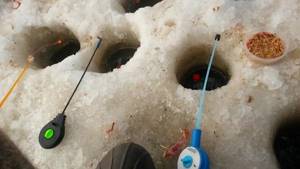
Lures and baits for catching crucian carp
Catchable jigs. Secrets: metal jigs with a soldered hook are used as bait for winter fishing for crucian carp. Jigs of natural colors - copper, lead, brass - are best suited for this. The through hole in the jig is intended for attaching fishing line. The hook used is No. 2.5 – 4.
The thickness of the fishing line is selected in proportion to the weight of the jig. The most popular diameter for catching crucian carp is from 0.08 mm to 0.15 mm.
The shape and size of the tackle is one of the important factors for a successful bite.
The most popular jigs for winter crucian carp fishing are:
- Pellet;
- Drop;
- Bug;
- Devil.
It is best to make a combined bait for a crucian carp jig: first place a maggot on the hook in the head area, and then a bloodworm, leaving a free tip. Thus, other insects and larvae of suitable sizes can be used.
Crucian carp is very fond of vegetable baits based on boiled porridges and cereals:
- Mastyrka is peas boiled into porridge, to which semolina is added. Everything is kneaded until it becomes plasticine;
- semolina , obtained by mixing cereal with a small amount of water for a long time (15 minutes);
- dough or bread softened in your hands ;
- pearl barley steamed in a thermos;
- canned corn is a delicacy for large crucian carp;
- boiled peas - also for large fish;
- boiled wheat.
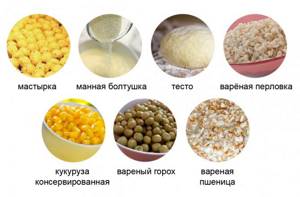
If you want to catch a large crucian carp, it is better to use bait of animal origin - bloodworms , worms or maggots .
We recommend watching an interesting video about catching crucian carp in the Ural reservoirs almost at night.
Seasonality
After the ice has formed, if the pond freezes abruptly and unexpectedly, or severe frosts hit, within a week the silverback will adapt to the new living conditions. If the freezing occurred slowly, then the bite of crucian carp on the first ice, on the contrary, can be strong, at times developing into a glutton. The places for fishing during this period are already winter. You can find the hybrid in holes near summer camp sites. However, in some places the crucian carp stands in the grass all winter.
Crucian carp in December
On some reservoirs in December the bite is quite stable, but it fades away and by January it enters the dead-winter stage. The fish are in the winter pits, and activity decreases as the weather gets colder. With the onset of winter, we switch to thinner rigs, small dark jigs and a bait of 1-2 bloodworms. In remote silted ponds, the silverback practically does not go out in search of food at this time and falls into suspended animation, burrowing into the bottom sediments. On large reservoirs it is important to find cool places - they will work with periodic success all winter, until the start of migration closer to spring.
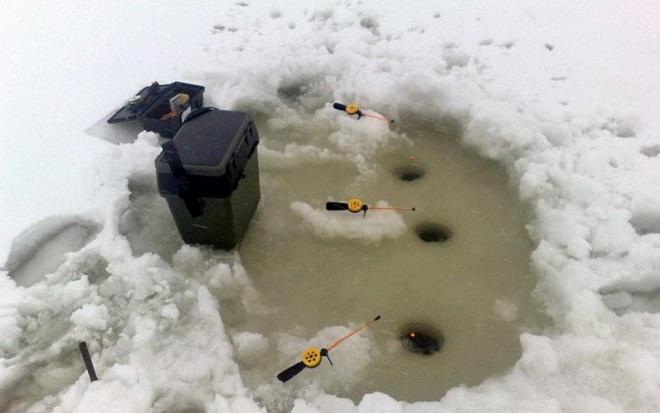
Glukhozimye
- In January and February, fishing is determined by the conditions of the reservoir. In the remote ponds in the north, the silverback sleeps, but in the clay ponds of the south it feeds, and this happens both in the pits and in the coastal grass. The lack of normal conditions for wintering forces crucian carp to look for food in the wilderness. You can catch it in rivers or reservoirs if you know the fishing spot.
- Fish in the dead of winter try not to waste energy. Perhaps feeding trips occur at a specific time and last no more than an hour or two. We use the thinnest winter equipment and delicate gear, sluggish play of jigs or fishing with a riser.
- In February, in the north and in the middle zone, the silverback sleeps. However, in the south, especially in large bodies of water, crucian carp become more active in February, gather in schools and come closer to the shores, into the bays of tributaries flowing into them, and stay at depths of 3-5 meters near the shallows, which they will move to when the ice melts.
- At this time, the main thing is to find the flock, and at the time when it is feeding. The best bite in winter is observed on warm, quiet days. However, this is not a rule. It happens that the hybrid survives in frosty temperatures of -20 degrees, or at night, together with roaches.
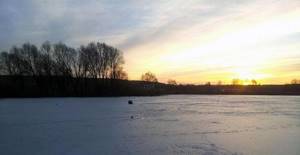
Fishing in March and on the last ice
You can successfully catch crucian carp from the ice in March wherever this fish does not sleep, if you manage to find a parking spot. The most promising reservoirs are large reservoirs, close to the shore or in tributary bays. In the north, crucian carp are practically not active at this time.
In some reservoirs you can catch crucian carp on the last ice, especially in the southern regions. Catching this fish in early spring from ice is the main pleasure of anglers, since the hybrid has practically replaced bream, and is present in large quantities in all reservoirs. In the middle zone, you can catch a silverfish during thaws and quiet warm days, both on pay zones and on natural reservoirs (except for silted shallow ponds and oxbow lakes).
Details about winter fishing for crucian carp (other articles):

